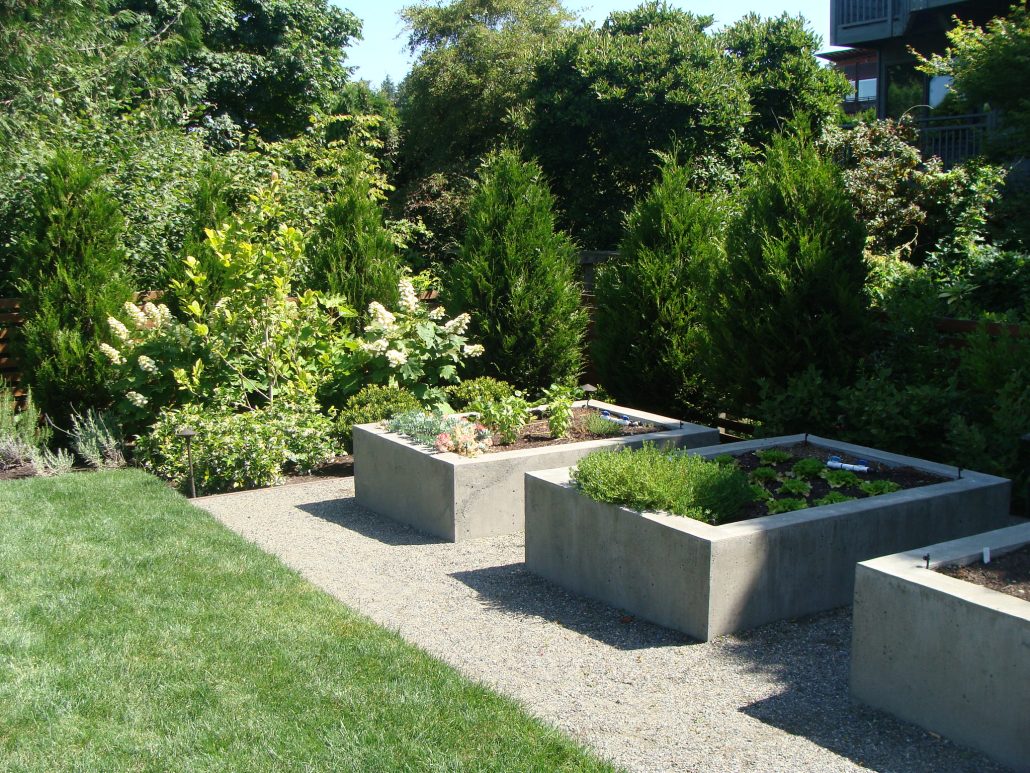Creating a Beautiful and Productive Edible Landscape: Tips and Ideas – By Alice Robertson for Seattle Landscape Architect Brooks Kolb

Photo by Brooks Kolb
Edible landscaping is an exciting concept that combines the aesthetic beauty of a traditional garden with the functional benefits of a home-grown food source. Imagine stepping out into your yard and plucking fresh herbs, fruits, and vegetables for your evening meal, all while enjoying a stunning visual environment. This approach to gardening allows you to make the most of your outdoor space, elevating it from merely decorative to deliciously practical. In this article by Brooks Kolb LLC, Landscape Architects, we’ll delve into various tips and ideas to help you create an edible landscape that’s both functional and visually pleasing.
Keep Colors and Flavors Exciting
When planning your edible garden, don’t overlook the power of edible flowers like nasturtiums, violets, and calendulas: Top 12 Edible Flowers and Their Various Health Benefits – Dr. Axe (draxe.com) These blooms not only provide a pop of color but can also be used in your culinary endeavors. Edible flowers can be sprinkled on salads, used to garnish desserts, or even steeped to make teas. Edible Flowers and How to Use Them (marthastewart.com) They offer an excellent way to infuse vibrant colors and subtle flavors into both your garden and your meals.
Think Vertically
Vertical gardening can significantly maximize your growing area, especially if you have limited ground space: How to Utilize Vertical Gardening For Maximizing Space (trugreenmidsouth.com) Utilize trellises, arbors, or supports for plants like beans, cucumbers, and tomatoes. These structures allow your plants to grow upwards, making efficient use of available space and adding a touch of beauty. Climbing plants on elegant structures creates an eye-catching element that’s both useful and artistic.
Got Pests? Use Companion Planting
Companion planting involves growing different types of plants together that can benefit each other in various ways, such as natural pest control: The power of companion planting | Kew For instance, basil can deter thrips and mosquitoes, making it a great companion for tomatoes. This technique not only helps you to keep harmful pests at bay but also promotes a balanced and healthy garden ecosystem.
Explore Eco-Friendly Pest Solutions
Aside from companion planting, there are other eco-friendly solutions for keeping pests out of your edible garden. Planting geraniums or African marigolds can deter Japanese beetles, reducing the need for chemical pesticides: Where Do Japanese Beetles Go at Night? – Home Garden Hero These natural alternatives are not only better for the environment but also ensure that your home-grown produce remains chemical-free and organic.
Use Mulch Weed Control and Soil Maintenance
Mulching is an essential step in creating a low-maintenance, productive garden. Organic mulches like straw, wood chips, or compost help retain soil moisture and suppress weed growth. This adds to the overall neat appearance of your garden and saves you the trouble of frequent weeding and watering.
Use Vines to Create a Natural Canopy
To achieve a garden that’s both visually stunning and bountiful, consider incorporating edible vines like grape or kiwi into your landscape design. These fast-growing vines can be expertly trained to climb over pergolas or archways, forming a lush, natural canopy that offers much-needed shade and imbues your outdoor space with a serene ambiance. The cherry on top of this charming setup is the delicious fruit these vines produce, allowing you to enjoy fresh, home-grown treats straight from the vine. This approach melds aesthetic appeal with practical utility, making your garden a feast for both the eyes and the palate.
Invite Friends to a Garden Party
One of the most enjoyable ways to appreciate your edible landscape is by sharing it with others. Invite family and friends to a garden party or an al fresco dinner featuring produce from your garden. There are numerous online platforms offering hassle-free templates for your invites, making the planning process simple and enjoyable: Free Invitation Maker with Online Templates | Adobe Express You can even upload your own photos to include in the invites (as well as add color and text) to make them superb.
Monetize Your Garden Through Education
If you’ve become a pro at edible landscaping, why not monetize your expertise? Starting a YouTube channel or even a small business offering edible garden consulting could be lucrative and fulfilling. If you decide to take the business route, forming an LLC via ZenBusiness offers benefits like limited liability, tax advantages, and more flexibility in your operations: How to Start an LLC in Washington for $0 | WA LLC Registration | ZenBusiness Inc.
Creating an edible landscape that’s both functional and beautiful is an achievable goal with a bit of planning and creativity. From incorporating edible flowers and utilizing vertical space to exploring eco-friendly pest control and even monetizing your expertise, the possibilities are endless. By implementing these tips and ideas, you can transform your outdoor area into a vibrant, productive, and visually appealing space. And if you’d rather leave this job to the pros, get in touch with Brooks Kolb LLC, Landscape Architecture today.
You can reach Alice Robertson at alice@tidyhome.info.


